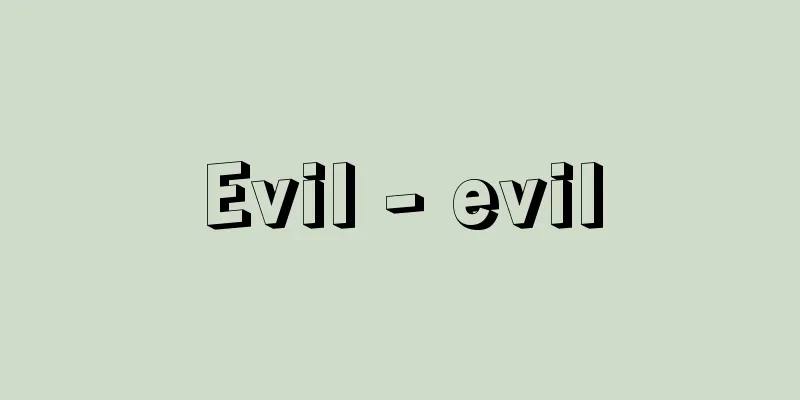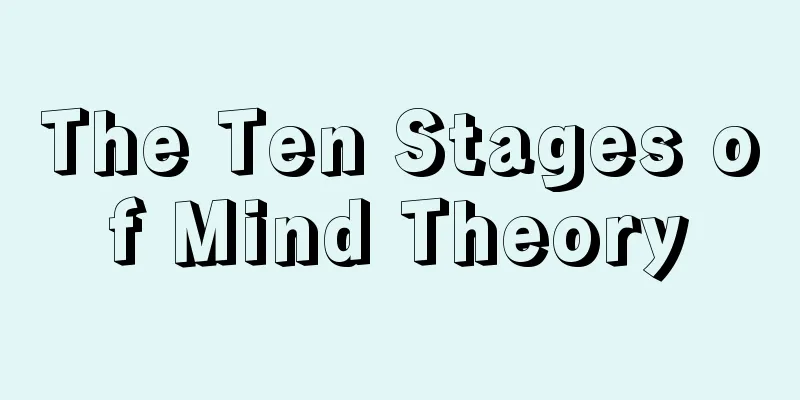Evil - evil

|
It refers to objects, actions, and situations that humans consider negative, and are the opposite of good as a positive value. If we define it formally like this, the distinction between good and evil can be found in all human societies, but what is actually considered good and evil varies depending on the human environment, social structure, and mental abilities, and is not uniform. It is deeply related to the religions and morality of humanity, and is an important subject of philosophical reflection. [Tokuyoshi Tamaru] The Evil of Primitive SocietiesGenerally speaking, in primitive societies, because moral consciousness is undifferentiated, there is a strong tendency to make no clear distinction between natural evil (harm) and ultimate evil based on human will. Evil is often objectified as something that originates from superhuman powers or spirits, while the restriction of evil acts takes the form of various taboos. For example, in Shintoism, which is an indigenous belief in Japan, moral good and evil, as well as good and bad fortune and misfortune, are both expressed with the words yoshi-ashi, and no particular difference is considered between them. Evil, expressed with the word mag, means an action that disrupts the order of the world, and is said to originate from Magatsuhi no Kami, a god born from the impurity of death. In general, the idea of attributing evil to a superhuman principle has remained deeply rooted to later times and is found in world religions. Examples include Satan in Christianity, Shaitan in Islam, and Mara in Buddhist scriptures. [Tokuyoshi Tamaru] Awakening of moral consciousness and good and evilThis state of affairs changes with the awakening of moral consciousness, which becomes evident at a certain stage. That is, evil is considered solely as a mode of human will and is distinguished from external factors. It is difficult to determine when this change occurred, but it is true that signs of it began to appear in some societies around the several centuries B.C. The conflict between the belief in human nature as good and that of evil in ancient China is one example, but the ideas of the ancient Stoics are another example. In the Stoics, being virtuous and living in accordance with nature (true nature) was good, and going against nature was evil, and all other things, such as life, health, pleasure, illness, suffering, and even death, were considered adiapora (absent). This shows a way of thinking that strictly limits good and evil to the actions of human will. This Stoic thought can be seen as a preliminary to the later theory of good and evil, or of value. Speaking only of evil, it has generally been divided into three or four categories: natural evil (natural disasters, disease, etc.), sensuous evil (pain), moral evil (guilt), and metaphysical evil (finiteness). The first two of these can be considered as being caused by external causes. Leibniz systematically addressed the problem of the origin of evil, which was already seen in fragments in Augustine and others, and developed the so-called "theism." He ultimately attributed these evils to finiteness, and explained it as a lack of good. [Tokuyoshi Tamaru] The origin of evil and its overcomingThe origin and nature of evil, together with its form and criteria, are important themes of philosophical reflection. It is also a question of the final order of things, and is therefore deeply related to the dimension of religion. There have been roughly three main positions on this issue. The first, as mentioned above, sees evil as a kind of substance, and is typified by the dualism of Zoroastrianism, which preaches the battle between two gods, good and evil. The second is the Vedanta school (Indian orthodox thought that follows on from the Upanishads, the esoteric texts of the Vedic scriptures) and Buddhism, which see all evil as the product of delusion or ignorance, which ultimately means a monistic position that seeks to resolve the issue by considering evil as non-existent. And the third is an eclectic position, as seen in the above-mentioned Christian theism, which acknowledges the reality of evil, but ultimately seeks to subsume it in God's providence. What should be noted here is that, unlike morality, religion, no matter which of the three positions it takes, ultimately aims to overcome and appease evil in the human world, even as it acknowledges the existence of evil. In this way, an important role of religion is to give meaning to the experience of the undeniable existence of evil. [Tokuyoshi Tamaru] [Reference] |Source: Shogakukan Encyclopedia Nipponica About Encyclopedia Nipponica Information | Legend |
|
人間にとって否定的と評価される対象、行為、事態をさし、肯定的な価値としての善の対(つい)をなすもの。このように形式的に定義するならば、善と悪との区別はすべての人間社会にみられるものであるが、ただ実際に何が善とされ、また悪とされるかの内容は、人間の環境、社会構造、精神的能力などによって変化し、一様ではない。それは人類の諸宗教ならびに道徳と深くかかわり、また哲学的反省の重要な課題をなしている。 [田丸徳善] 未開社会の悪ごく概括的にいえば、未開社会にあっては道徳的意識が未分化であるため、自然的な悪(害悪)と人間の意志に基づく勝義での悪とが明らかに区別されない傾向が強い。悪は、しばしば超人間的な力や神霊に由来するものとして対象化される一方、悪(あ)しき行為の規制はさまざまのタブー(禁忌(きんき))の形をとって行われた。たとえば、わが国の固有信仰である神道では、道徳的な善悪も吉凶禍福もともにヨシ―アシということばで表され、それらの間にとくに差異が考えられなかった。マガということばで表現される悪は、世界の秩序を混乱させる作用を意味し、死の穢(けがれ)から生まれた禍津日神(まがつひのかみ)に由来するとされた。一般に悪を超人間的な原理に帰する考え方は、後の時代までも根強く残り、世界宗教のなかにも認められる。キリスト教のサタン、イスラム教のシャイターン、仏教経典にみえるマーラなどがそれにあたる。 [田丸徳善] 道徳的意識の覚醒と善悪このような状態は、ある段階から顕著になる道徳的意識の覚醒(かくせい)に伴って変わってくる。すなわち、悪はもっぱら人間の意志の様態と考えられるようになり、外的な要因から区別される。この変化がいつおこったかは確定しがたいが、いくつかの社会で紀元前数世紀ごろからその兆候が現れてくることは事実である。古代中国における性善説と性悪説との対立はその一例であるが、古代ストア学派の思想はもう一つの例証といってよい。ストア学派では、有徳であること、自然(本性)に従って生きることが善であり、自然に反することが悪であって、それ以外の生命、健康、快楽、病苦、そして死さえもが、どちらでもよいアディアポラ(無記)とされた。ここには、善悪を厳しく人間の意志作用に限定する考え方が示されている。 このストアの思想は、のちに成立する善悪、あるいは価値の理論への一つの準備形態とみることもできる。いま悪に限っていえば、それは概して三つないし四つの範疇(はんちゅう)に分けられてきた。すなわち、自然的悪(天災、病など)、感覚的悪(苦痛)、道徳的悪(罪責)、形而上(けいじじょう)学的悪(有限性)であり、このなかで最初の二つは、外的な原因によるものとして一括してみてもよい。ライプニッツは、すでにアウグスティヌスなどにも断片的にみられる悪の起源の問題を体系的に取り上げ、いわゆる「弁神論」を展開した。彼はこれらの諸悪を最終的には有限性によるものとし、しかもそれを善の欠如態として説明している。 [田丸徳善] 悪の起源とその克服悪の起源と本質というこの問題は、その様態や基準とともに、哲学的反省の重要な主題をなす。またそれは事物の最終的秩序の問題でもあるから、宗教の次元とも深くかかわってくる。それについては従来ほぼ三つのおもな立場があった。一つは、前述のように悪をいわば実体化してみるものであり、善悪2神の戦いを説くゾロアスター教の二元論がその典型といえる。第二は、諸悪を迷妄ないし無明(むみょう)の所産とみなすベーダーンタ学派(ベーダ聖典の奥義書ウパニシャッドの流れを引くインドの正統思想)や仏教であり、これは究極的には悪を非存在とみなすことで解決しようとする一元論的立場を意味する。そして第三は、上記のキリスト教弁神論にみるように、悪の現実性を認めつつ、しかも最終的にはそれを神の摂理に包摂しようとする折衷的立場である。 ここで注意すべきことは、宗教においては、道徳と異なって、三つのうちどの立場をとるにせよ、人間世界の悪を認めながらも、最終的にはその克服、宥和(ゆうわ)が目ざされるということである。このように、否定しがたい悪の存在の体験をも意味づけるところに、宗教の重要な働きがある。 [田丸徳善] [参照項目] |出典 小学館 日本大百科全書(ニッポニカ)日本大百科全書(ニッポニカ)について 情報 | 凡例 |
<<: Aguascalientes (English spelling)
>>: Lye (lye) - lye (English spelling)
Recommend
Umeda
The area is located in the central part of Osaka ...
Dyula
...Mande languages have a large number of speak...
Espata danza - Espata danza
...There are many other folk songs with beautiful...
Meek, JM (English spelling) MeekJM
…The second stage of the discharge path formation...
Base issue - crazy issue
This refers to the problems that arise from the e...
Pixelecourt - Pixelecourt (English) René Charles Guilbert de Pixérécourt
French playwright and master of melodrama. Born i...
Saiga Rebellion - Saikaiikki
A regional association during the Sengoku period....
Microphage
…also called macrophages. E. Metchnikoff, the dis...
NNTP - NNTP
A protocol for distributing and transferring netne...
Dog roundworm - dog roundworm
…A human parasite belonging to the family Coleopt...
Yuyu - Yuyu
〘Noun〙 (often used with "en'nyuu") A...
Shared expenses - Kyoyouhi
…Creditors who incur these expenses are given pri...
Suki - I like it
{The same origin as "suki" (like). "...
Dance flies
A general term for insects belonging to the family...
Support - Shikou
A haiku poet from the mid-Edo period. Kagami. His...









